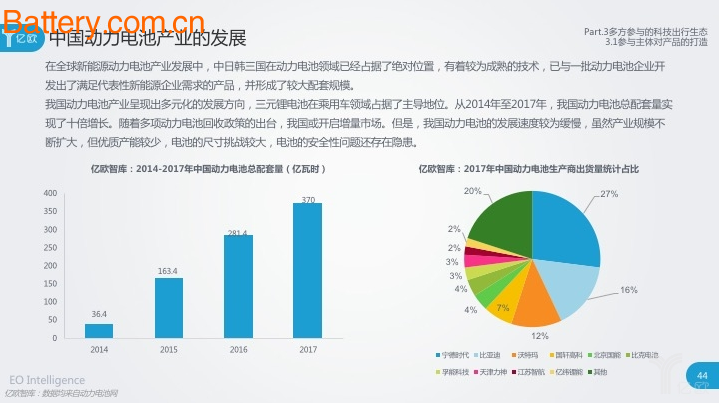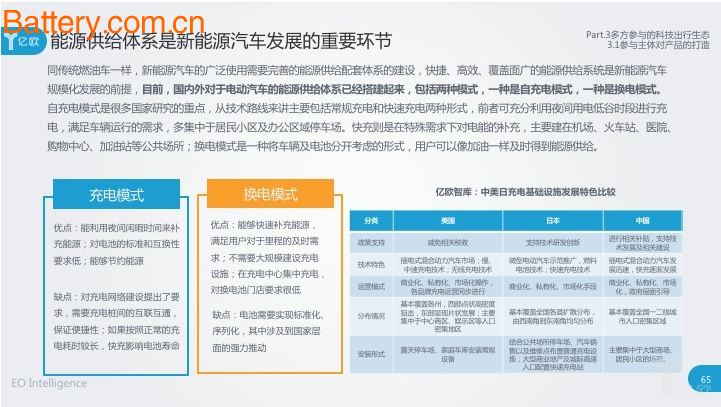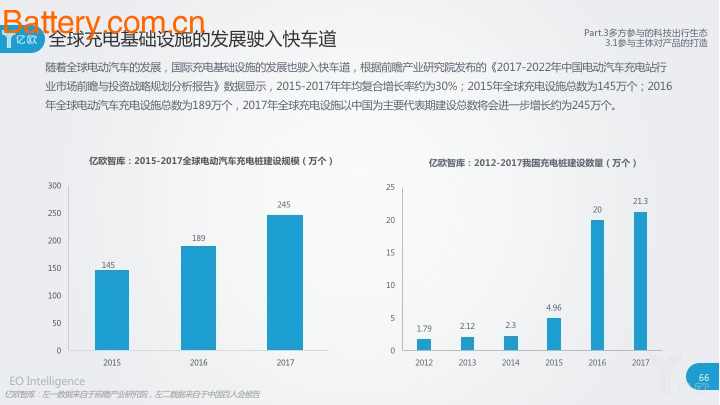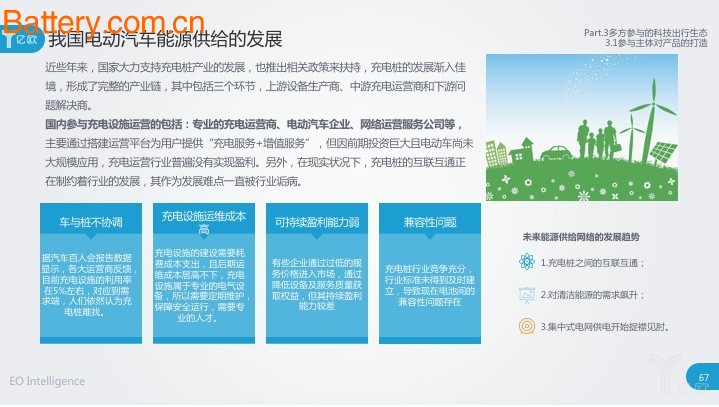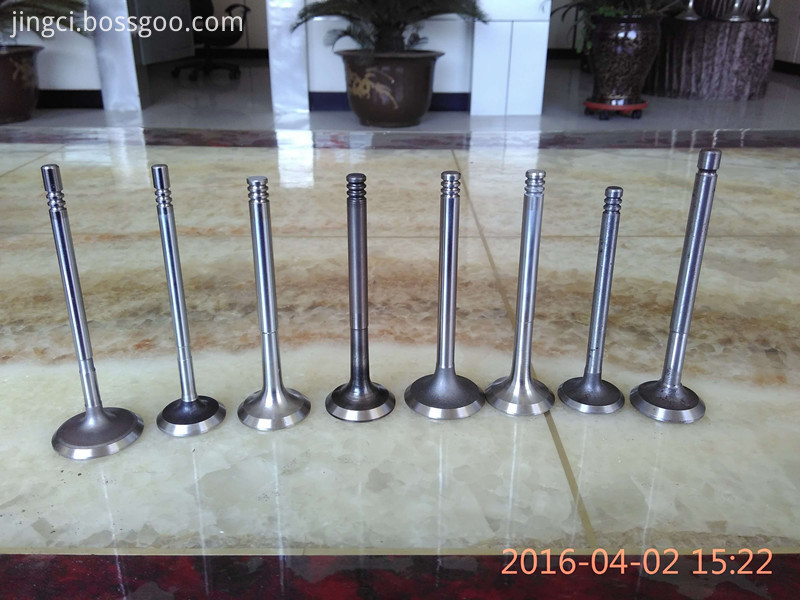In recent years, China's new energy automobile industry has developed rapidly. In 2017, China's new energy vehicle production and sales exceeded 700,000 units. The number of new energy vehicles has exceeded 1.8 million. In recent years, production and sales are expected to reach 1 million units, which will be driven by the production and sales of new energy vehicles. China's electric vehicle related technology and supporting infrastructure construction has also achieved certain development, which is embodied in the aspects of battery, power consumption and charging. Power battery technology is developing rapidly, and the phase of elimination or merger will be ushered in the future. China's electric car battery technology road is divided into two kinds of lithium batteries and fuel cells, the major domestic lithium-based batteries. Compared with foreign countries, the technical level of domestically developed lithium-ion battery cells is basically at the same level as that of foreign countries. China's power battery shipments have already ranked among the world's leading companies, whether it is cathode materials, lithium iron phosphate, ternary, high-electric manganese. Other materials are in an advantageous position. Data show that from 2014 to 2017, China's total power battery capacity has increased steadily, from 3.64 billion WH to 37.06 billion WH, achieving significant growth, mainly due to power battery manufacturers. The number has increased. In terms of policy support, the relevant state departments have also expressed their emphasis on the development of the power battery sector, covering the power battery industry specifications, power battery industry development, power battery standards, power battery recycling and other aspects. In 2015, the National Development and Reform Commission issued the “Guidelines for the Development of Electric Vehicle Charging Infrastructure (2015-2020)â€. The guideline states that by 2020, more than 120,000 new centralized charging and replacement stations will be added, and distributed charging piles will exceed 480. Ten thousand, to meet the national 5 million electric vehicle charging needs, the planned pile-to-pile ratio should be close to 1:1. Meanwhile, China has also developed a series of development plans based on foreign experience, show planning, by 2020, the mass density of the battery module reaches 300Wh / kg or more, the cost dropped to 1.5 yuan / Wh or less, details are as follows: Although the pace of development of power battery amazing, but in fact, by 2017 China's total power demand or lack of battery 3.5 billion WH, shows that battery market will usher in the next phase of overcapacity. So, in the next stage, the Chinese government or to adjust their development strategies, coordinate and guide the healthy development of battery industry. There has also been news in the industry that subsidies for new energy vehicles have entered a phase of retreat. There is no doubt that the power battery industry will also be affected. In addition, from the perspective of the industry pattern, the latest data shows that in the first quarter of 2018, the installed capacity of lithium-ion batteries in the Ningde era accounted for half of the total, accounting for 49.5%; the second was BYD, accounting for 19.8%; The third is Guoxuan High-Tech, accounting for 8.7%. The top three producers account for the vast majority of the market, which is enough to imply that the power battery market is about to usher in the phase of mergers and acquisitions. However, due to the cost of new energy materials, the profit of China's power battery industry is decreasing. Experts predict that the gross profit margin of power battery companies will fall from around 30% to around 20% in 2018. Supporting infrastructure construction is constantly improving, but the demand does not match Like the development of the power battery market, the extensive use of new energy vehicles requires the construction of a sound energy supply supporting system. At present, the energy supply system has been set up at home and abroad, including two modes: one is self-charging mode and the other is power-changing mode. Among them, the self-charging mode is the focus of research in many countries. As can be seen from the following figure, China's charging pile construction has entered the fast lane, from 17,900 in 2012 to 213,000 in 2017, which has formed a certain scale, ranking first in the world. However, it also faces certain problems in the development process, that is, the utilization efficiency of the charging pile is low, the layout of the charging facility is not reasonable, and the development model of sustainable business has not yet been formed. In addition, in some areas, parking fees are more expensive than charging charges, and charging stations are occupied by oil trucks, resulting in poor user experience. In addition, the interconnection between charging piles has always been a pain point for the development of the industry, because it involves the user's application of charging piles, and also enables enterprises to better operate charging piles. Therefore, many companies have begun to devote themselves to this pain point, but they have not achieved results. However, there is no doubt that under the general trend of new energy vehicles, the number of new energy vehicles is increasing, people's demand for charging facilities will be more vigorous, and the construction of charging infrastructure will continue to improve in the future. At the same time, the government will continue to play. Guide the role, introduce relevant policies, and promote the development of charging pile construction and operation in the direction of health; and in the future, with the improvement of Internet +, Internet of Things, and big data technology, the future charging pile infrastructure will continue to deepen the information openness, and ultimately Realize interconnection.
Valves is one of the key components that affect engine reliability and safety. It's mainly used to start and shut down the intake and exhaust passages during engine operation, to control the intake of fuel mixture or air and the discharge of exhaust gases. . The working environment of the valve and Valve Seat is very harsh. In addition to the corrosion of high temperature gas, it also bears the impact of the burst pressure in the cylinder.
The material of the valve is usually divided into 40Cr, 4Cr9Si2, 4Cr10Si2Mo, 21-4N and 23-8N in China. 5Cr8Si2, 4Cr9Si3, 21-2N, 21-12N, 23-8N, XB, etc. have been used in large quantities on some imported models. High-temperature nickel-based alloys are also being used on high-load diesel exhaust valves.
Truck Engine Valve,Truck Diesel Engine Valve,Exhaust Valve For Engine,Truck Generator Set Engine Valves Hebei Zhonghai Shipping Accessories Manufacturing Co., Ltd. , https://www.zhonghaiship.com